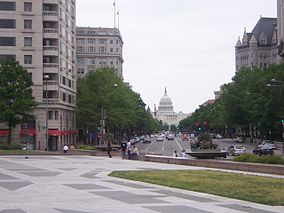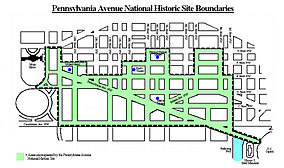Pennsylvania Avenue National Historic Site
| Pennsylvania Avenue National Historic Site | |
|---|---|

Looking southeast down Pennsylvania Avenue N.W. in 2006. Freedom Plaza is in the foreground, with its granite inlay map and original street-grid diagram from 1791 of District of Columbia architect Pierre L'Enfant visible on the ground. The tall building on the left behind the trees is 1111 Pennsylvania Avenue. The Old Post Office Pavilion (former General Post Office for the old United States Post Office Department) is visible to the right, and the United States Capitol is in the far distance to the southeast.
|
|
 |
|
| Location | Washington, D.C., U.S. |
| Coordinates | 38°53′37″N 77°01′26″W / 38.89361°N 77.02389°WCoordinates: 38°53′37″N 77°01′26″W / 38.89361°N 77.02389°W |
| Area | 20.6 acres (8.3 ha) |
| Established | September 30, 1965 |
| Governing body | National Park Service, U.S. Dept. of the Interior |
| Website | |
|
Pennsylvania Avenue National Historic Site
|
|
| NRHP Reference # | 66000865 |
| Added to NRHP | October 15, 1966 |
Pennsylvania Avenue National Historic Site
Pennsylvania Avenue National Historic Site is a National Historic Site in the city of Washington, D.C. Established on September 30, 1965, the site is roughly bounded by Constitution Avenue, 15th Street NW, F Street NW, and 3rd Street NW. The historic district includes a number of culturally, aesthetically, and historically significant structures and places, including Pennsylvania Avenue NW from the White House to the United States Capitol, the Treasury Building, Freedom Plaza, Federal Triangle, Ford's Theatre, the Old Patent Office Building, the Old Pension Office Building (which now houses the National Building Museum), Judiciary Square, and the Peace Monument.
Pennsylvania Avenue, the heart of the historic site, is recognized by many as "America's Main Street", and the avenue plays a significant part in American political culture. A march or event held on the avenue is infused with a great deal of political meaning.
Prior to the settlement of the area by European colonists, the Piscataway tribe of Native Americans occupied the northeastern banks of the Potomac River, although no permanent settlements are known in the area now encompassed by the city of Washington. After seizure of the land by European settlers, David Burns obtained the first title to the area which would become Pennsylvania Avenue NW in 1774.
...
Wikipedia
